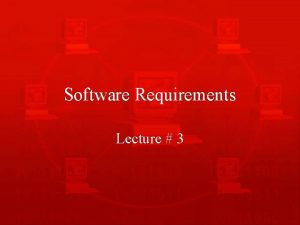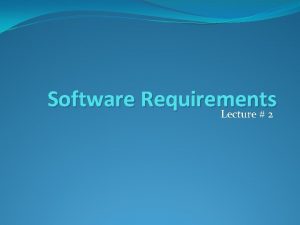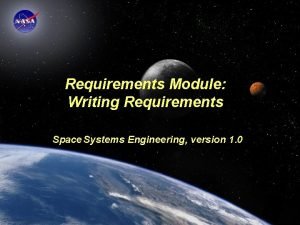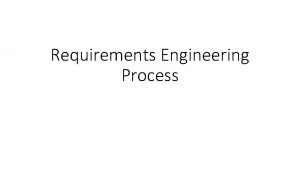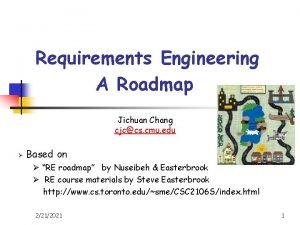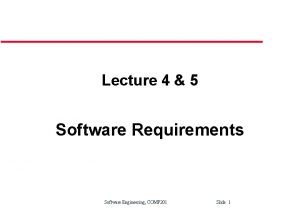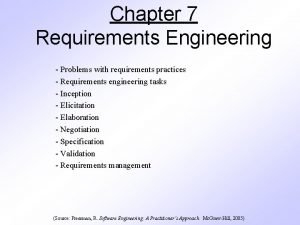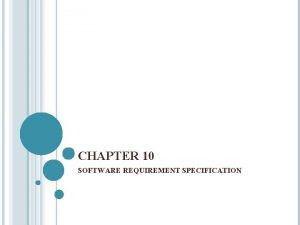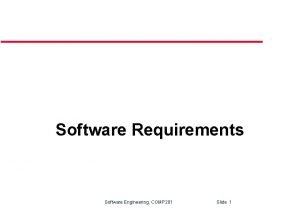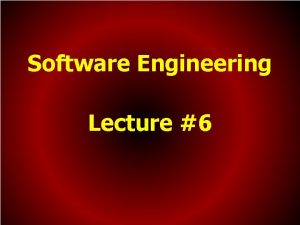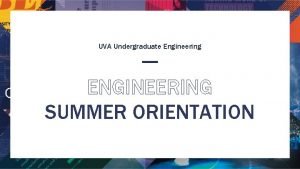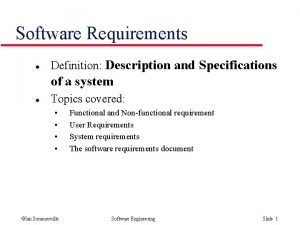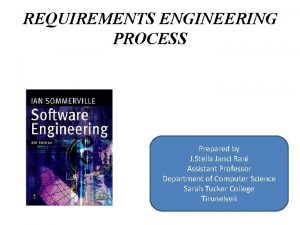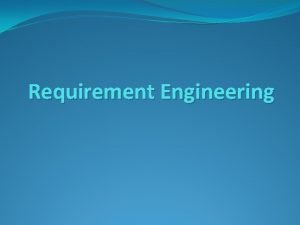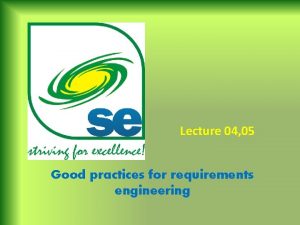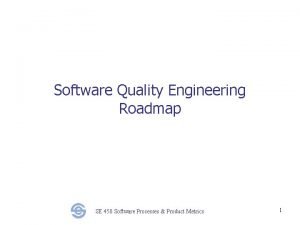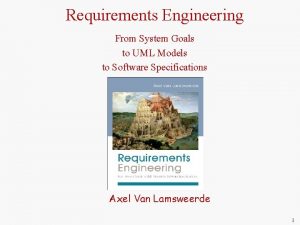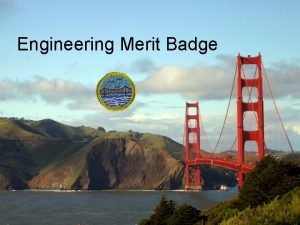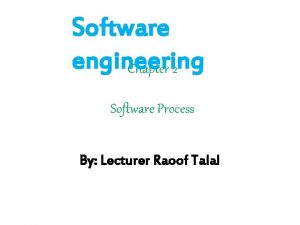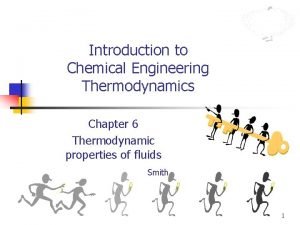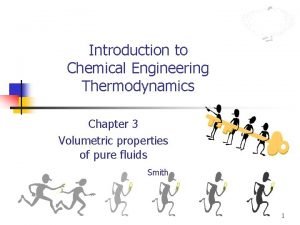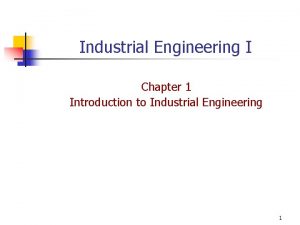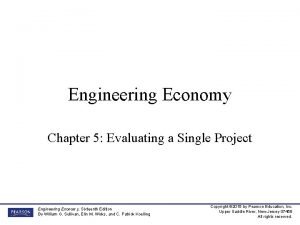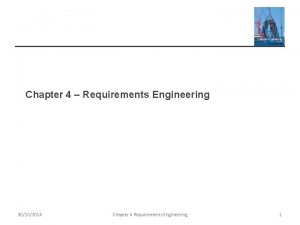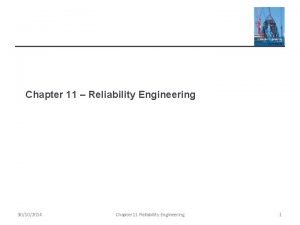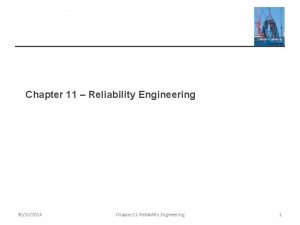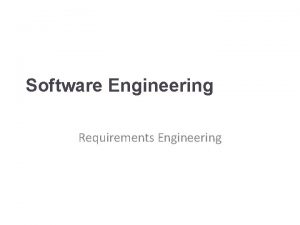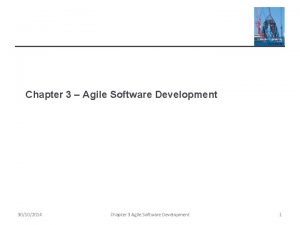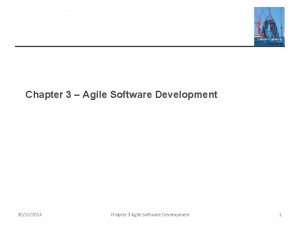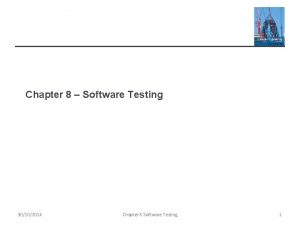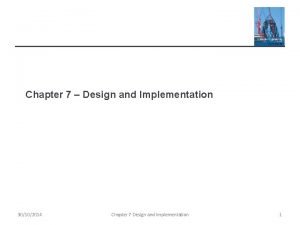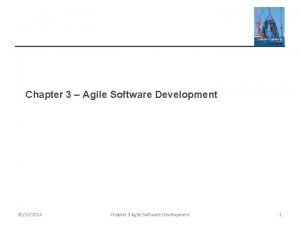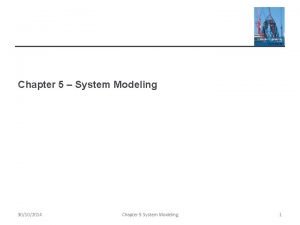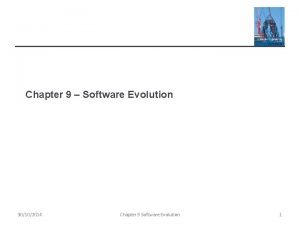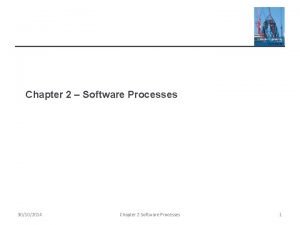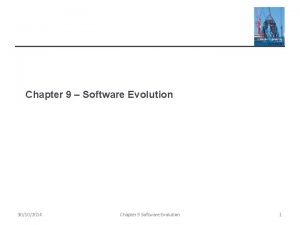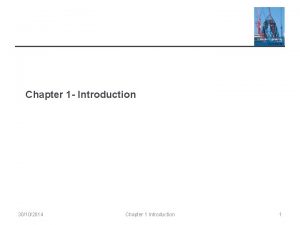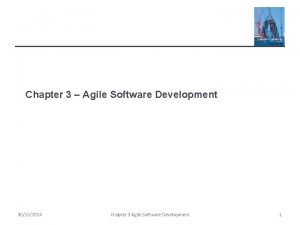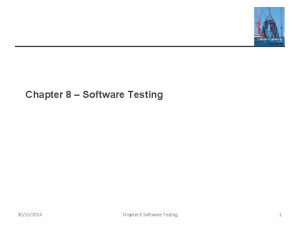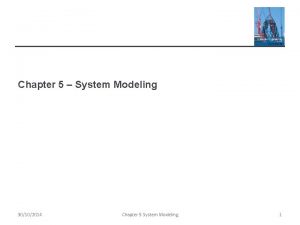Chapter 4 Requirements Engineering 30102014 Chapter 4 Requirements




































- Slides: 36

Chapter 4 – Requirements Engineering 30/10/2014 Chapter 4 Requirements Engineering 1

Topics covered ² Requirements engineering processes ² Requirements elicitation 30/10/2014 Chapter 4 Requirements Engineering 2

Requirements engineering ² The process of establishing the services that a customer requires from a system and the constraints under which it operates and is developed. ² The system requirements are the descriptions of the system services and constraints that are generated during the requirements engineering process. 30/10/2014 Chapter 4 Requirements Engineering 3

What is a requirement? ² It may range from a high-level abstract statement of a service or of a system constraint to a detailed mathematical functional specification. ² This is inevitable as requirements may serve a dual function § May be the basis for a bid for a contract - therefore must be open to interpretation; § May be the basis for the contract itself - therefore must be defined in detail; § Both these statements may be called requirements. 30/10/2014 Chapter 4 Requirements Engineering 4

Requirements abstraction (Davis) “If a company wishes to let a contract for a large software development project, it must define its needs in a sufficiently abstract way that a solution is not pre-defined. The requirements must be written so that several contractors can bid for the contract, offering, perhaps, different ways of meeting the client organization’s needs. Once a contract has been awarded, the contractor must write a system definition for the client in more detail so that the client understands and can validate what the software will do. Both of these documents may be called the requirements document for the system. ” 30/10/2014 Chapter 4 Requirements Engineering 5

Types of requirement ² User requirements § Statements in natural language plus diagrams of the services the system provides and its operational constraints. Written for customers. ² System requirements § A structured document setting out detailed descriptions of the system’s functions, services and operational constraints. Defines what should be implemented so may be part of a contract between client and contractor. 30/10/2014 Chapter 4 Requirements Engineering 6

User and system requirements 30/10/2014 Chapter 4 Requirements Engineering 7

Readers of different types of requirements specification 30/10/2014 Chapter 4 Requirements Engineering 8

System stakeholders ² Any person or organization who is affected by the system in some way and so who has a legitimate interest ² Stakeholder types § § 30/10/2014 End users System managers System owners External stakeholders Chapter 4 Requirements Engineering 9

Stakeholders in the Mentcare system ² Patients whose information is recorded in the system. ² Doctors who are responsible for assessing and treating patients. ² Nurses who coordinate the consultations with doctors and administer some treatments. ² Medical receptionists who manage patients’ appointments. ² IT staff who are responsible for installing and maintaining the system. 30/10/2014 Chapter 4 Requirements Engineering 10

Stakeholders in the Mentcare system ² A medical ethics manager who must ensure that the system meets current ethical guidelines for patient care. ² Health care managers who obtain management information from the system. ² Medical records staff who are responsible for ensuring that system information can be maintained and preserved, and that record keeping procedures have been properly implemented. 30/10/2014 Chapter 4 Requirements Engineering 11

Agile methods and requirements ² Many agile methods argue that producing detailed system requirements is a waste of time as requirements change so quickly. ² The requirements document is therefore always out of date. ² Agile methods usually use incremental requirements engineering and may express requirements as ‘user stories’ (discussed in Chapter 3). ² This is practical for business systems but problematic for systems that require pre-delivery analysis (e. g. critical systems) or systems developed by several teams. 30/10/2014 Chapter 4 Requirements Engineering 12

Requirements engineering processes 30/10/2014 Chapter 4 Requirements Engineering 13

Requirements engineering processes ² The processes used for RE vary widely depending on the application domain, the people involved and the organisation developing the requirements. ² However, there a number of generic activities common to all processes § § Requirements elicitation; Requirements analysis; Requirements validation; Requirements management. ² In practice, RE is an iterative activity in which these processes are interleaved. 30/10/2014 Chapter 4 Requirements Engineering 14

A spiral view of the requirements engineering process 30/10/2014 Chapter 4 Requirements Engineering 15

Requirements elicitation 30/10/2014 Chapter 4 Requirements Engineering 16

Requirements elicitation and analysis ² Sometimes called requirements elicitation or requirements discovery. ² Involves technical staff working with customers to find out about the application domain, the services that the system should provide and the system’s operational constraints. ² May involve end-users, managers, engineers involved in maintenance, domain experts, trade unions, etc. These are called stakeholders. 30/10/2014 Chapter 4 Requirements Engineering 17

Requirements elicitation ² Software engineers work with a range of system stakeholders to find out about the application domain, the services that the system should provide, the required system performance, hardware constraints, other systems, etc. ² Stages include: § § 30/10/2014 Requirements discovery, Requirements classification and organization, Requirements prioritization and negotiation, Requirements specification. Chapter 4 Requirements Engineering 18

Problems of requirements elicitation ² Stakeholders don’t know what they really want. ² Stakeholders express requirements in their own terms. ² Different stakeholders may have conflicting requirements. ² Organisational and political factors may influence the system requirements. ² The requirements change during the analysis process. New stakeholders may emerge and the business environment may change. 30/10/2014 Chapter 4 Requirements Engineering 19

The requirements elicitation and analysis process 30/10/2014 Chapter 4 Requirements Engineering 20

Process activities ² Requirements discovery § Interacting with stakeholders to discover their requirements. Domain requirements are also discovered at this stage. ² Requirements classification and organisation § Groups related requirements and organises them into coherent clusters. ² Prioritisation and negotiation § Prioritising requirements and resolving requirements conflicts. ² Requirements specification § Requirements are documented and input into the next round of the spiral. 30/10/2014 Chapter 4 Requirements Engineering 21

Requirements discovery ² The process of gathering information about the required and existing systems and distilling the user and system requirements from this information. ² Interaction is with system stakeholders from managers to external regulators. ² Systems normally have a range of stakeholders. 30/10/2014 Chapter 4 Requirements Engineering 22

Interviewing ² Formal or informal interviews with stakeholders are part of most RE processes. ² Types of interview § Closed interviews based on pre-determined list of questions § Open interviews where various issues are explored with stakeholders. ² Effective interviewing § Be open-minded, avoid pre-conceived ideas about the requirements and are willing to listen to stakeholders. § Prompt the interviewee to get discussions going using a springboard question, a requirements proposal, or by working together on a prototype system. 30/10/2014 Chapter 4 Requirements Engineering 23

Interviews in practice ² Normally a mix of closed and open-ended interviewing. ² Interviews are good for getting an overall understanding of what stakeholders do and how they might interact with the system. ² Interviewers need to be open-minded without preconceived ideas of what the system should do ² You need to prompt the use to talk about the system by suggesting requirements rather than simply asking them what they want. 30/10/2014 Chapter 4 Requirements Engineering 24

Problems with interviews ² Application specialists may use language to describe their work that isn’t easy for the requirements engineer to understand. ² Interviews are not good for understanding domain requirements § Requirements engineers cannot understand specific domain terminology; § Some domain knowledge is so familiar that people find it hard to articulate or think that it isn’t worth articulating. 30/10/2014 Chapter 4 Requirements Engineering 25

Ethnography ² A social scientist spends a considerable time observing and analysing how people actually work. ² People do not have to explain or articulate their work. ² Social and organisational factors of importance may be observed. ² Ethnographic studies have shown that work is usually richer and more complex than suggested by simple system models. 30/10/2014 Chapter 4 Requirements Engineering 26

Scope of ethnography ² Requirements that are derived from the way that people actually work rather than the way I which process definitions suggest that they ought to work. ² Requirements that are derived from cooperation and awareness of other people’s activities. § Awareness of what other people are doing leads to changes in the ways in which we do things. ² Ethnography is effective for understanding existing processes but cannot identify new features that should be added to a system. 30/10/2014 Chapter 4 Requirements Engineering 27

Focused ethnography ² Developed in a project studying the air traffic control process ² Combines ethnography with prototyping ² Prototype development results in unanswered questions which focus the ethnographic analysis. ² The problem with ethnography is that it studies existing practices which may have some historical basis which is no longer relevant. 30/10/2014 Chapter 4 Requirements Engineering 28

Ethnography and prototyping for requirements analysis 30/10/2014 Chapter 4 Requirements Engineering 29

Stories and scenarios ² Scenarios and user stories are real-life examples of how a system can be used. ² Stories and scenarios are a description of how a system may be used for a particular task. ² Because they are based on a practical situation, stakeholders can relate to them and can comment on their situation with respect to the story. 30/10/2014 Chapter 4 Requirements Engineering 30

Photo sharing in the classroom (i. Learn) ² Jack is a primary school teacher in Ullapool (a village in northern Scotland). He has decided that a class project should be focused around the fishing industry in the area, looking at the history, development and economic impact of fishing. As part of this, pupils are asked to gather and share reminiscences from relatives, use newspaper archives and collect old photographs related to fishing and fishing communities in the area. Pupils use an i. Learn wiki to gather together fishing stories and SCRAN (a history resources site) to access newspaper archives and photographs. However, Jack also needs a photo sharing site as he wants pupils to take and comment on each others’ photos and to upload scans of old photographs that they may have in their families. Jack sends an email to a primary school teachers group, which he is a member of to see if anyone can recommend an appropriate system. Two teachers reply and both suggest that he uses Kids. Take. Pics, a photo sharing site that allows teachers to check and moderate content. As Kids. Take. Pics is not integrated with the i. Learn authentication service, he sets up a teacher and a class account. He uses the i. Learn setup service to add Kids. Take. Pics to the services seen by the pupils in his class so that when they log in, they can immediately use the system to upload photos from their mobile devices and class computers. 30/10/2014 Chapter 4 Requirements Engineering 31

Scenarios ² A structured form of user story ² Scenarios should include § § § 30/10/2014 A description of the starting situation; A description of the normal flow of events; A description of what can go wrong; Information about other concurrent activities; A description of the state when the scenario finishes. Chapter 4 Requirements Engineering 32

Uploading photos i. Learn) ² Initial assumption: A user or a group of users have one or more digital photographs to be uploaded to the picture sharing site. These are saved on either a tablet or laptop computer. They have successfully logged on to Kids. Take. Pics. ² Normal: The user chooses upload photos and they are prompted to select the photos to be uploaded on their computer and to select the project name under which the photos will be stored. They should also be given the option of inputting keywords that should be associated with each uploaded photo. Uploaded photos are named by creating a conjunction of the user name with the filename of the photo on the local computer. ² On completion of the upload, the system automatically sends an email to the project moderator asking them to check new content and generates an on-screen message to the user that this has been done. 30/10/2014 Chapter 4 Requirements Engineering 33

Uploading photos ² What can go wrong: ² No moderator is associated with the selected project. An email is automatically generated to the school administrator asking them to nominate a project moderator. Users should be informed that there could be a delay in making their photos visible. ² Photos with the same name have already been uploaded by the same user. The user should be asked if they wish to re-upload the photos with the same name, rename the photos or cancel the upload. If they chose to re-upload the photos, the originals are overwritten. If they chose to rename the photos, a new name is automatically generated by adding a number to the existing file name. ² Other activities: The moderator may be logged on to the system and may approve photos as they are uploaded. ² System state on completion: User is logged on. The selected photos have been uploaded and assigned a status ‘awaiting moderation’. Photos are visible to the moderator and to the user who uploaded them. 30/10/2014 Chapter 4 Requirements Engineering 34

Key points ² Requirements for a software system set out what the system should do and define constraints on its operation and implementation. ² They often relate to the emergent properties of the system and therefore apply to the system as a whole. 30/10/2014 Chapter 4 Requirements Engineering 35

Key points ² The requirements engineering process is an iterative process that includes requirements elicitation, specification and validation. ² Requirements elicitation is an iterative process that can be represented as a spiral of activities – requirements discovery, requirements classification and organization, requirements negotiation and requirements documentation. ² You can use a range of techniques for requirements elicitation including interviews and ethnography. User stories and scenarios may be used to facilitate discussions. 30/10/2014 Chapter 4 Requirements Engineering 36
 Chapter 4 requirements engineering
Chapter 4 requirements engineering Engineering requirements document
Engineering requirements document Inverse requirements in software engineering
Inverse requirements in software engineering Inverse requirements
Inverse requirements Form-based specifications
Form-based specifications Requirements discovery techniques in software engineering
Requirements discovery techniques in software engineering Dfd symbols
Dfd symbols Requirements writing for system engineering
Requirements writing for system engineering What is domain requirements in software engineering
What is domain requirements in software engineering Requirements engineering process
Requirements engineering process Jichuan chang
Jichuan chang Domain requirements in software engineering
Domain requirements in software engineering Inception in requirement engineering
Inception in requirement engineering Srs in software engineering
Srs in software engineering User requirements software engineering
User requirements software engineering Initiating the requirements engineering process
Initiating the requirements engineering process Sources of requirements in software engineering
Sources of requirements in software engineering Uva summer orientation
Uva summer orientation What is domain requirements
What is domain requirements Feasibility studies for requirements engineering process
Feasibility studies for requirements engineering process Inception in requirement engineering
Inception in requirement engineering Good practices for requirements engineering
Good practices for requirements engineering Requirements engineering: a roadmap
Requirements engineering: a roadmap Requirements engineering uml
Requirements engineering uml Systems engineering approach boy scouts
Systems engineering approach boy scouts Computer based system engineering in software engineering
Computer based system engineering in software engineering Forward engineering and reverse engineering
Forward engineering and reverse engineering Principles of complex systems for systems engineering
Principles of complex systems for systems engineering Elegant systems
Elegant systems Reverse engineering vs forward engineering
Reverse engineering vs forward engineering Software engineering chapter 2
Software engineering chapter 2 Chemical engineering thermodynamics 8th solution chapter 6
Chemical engineering thermodynamics 8th solution chapter 6 Chemical engineering thermodynamics 8th solution chapter 3
Chemical engineering thermodynamics 8th solution chapter 3 Thermodynamics for chemical engineering
Thermodynamics for chemical engineering 7 industrial engineering tools
7 industrial engineering tools Two dimensional force system
Two dimensional force system Engineering economy 16th edition chapter 5 solutions
Engineering economy 16th edition chapter 5 solutions


